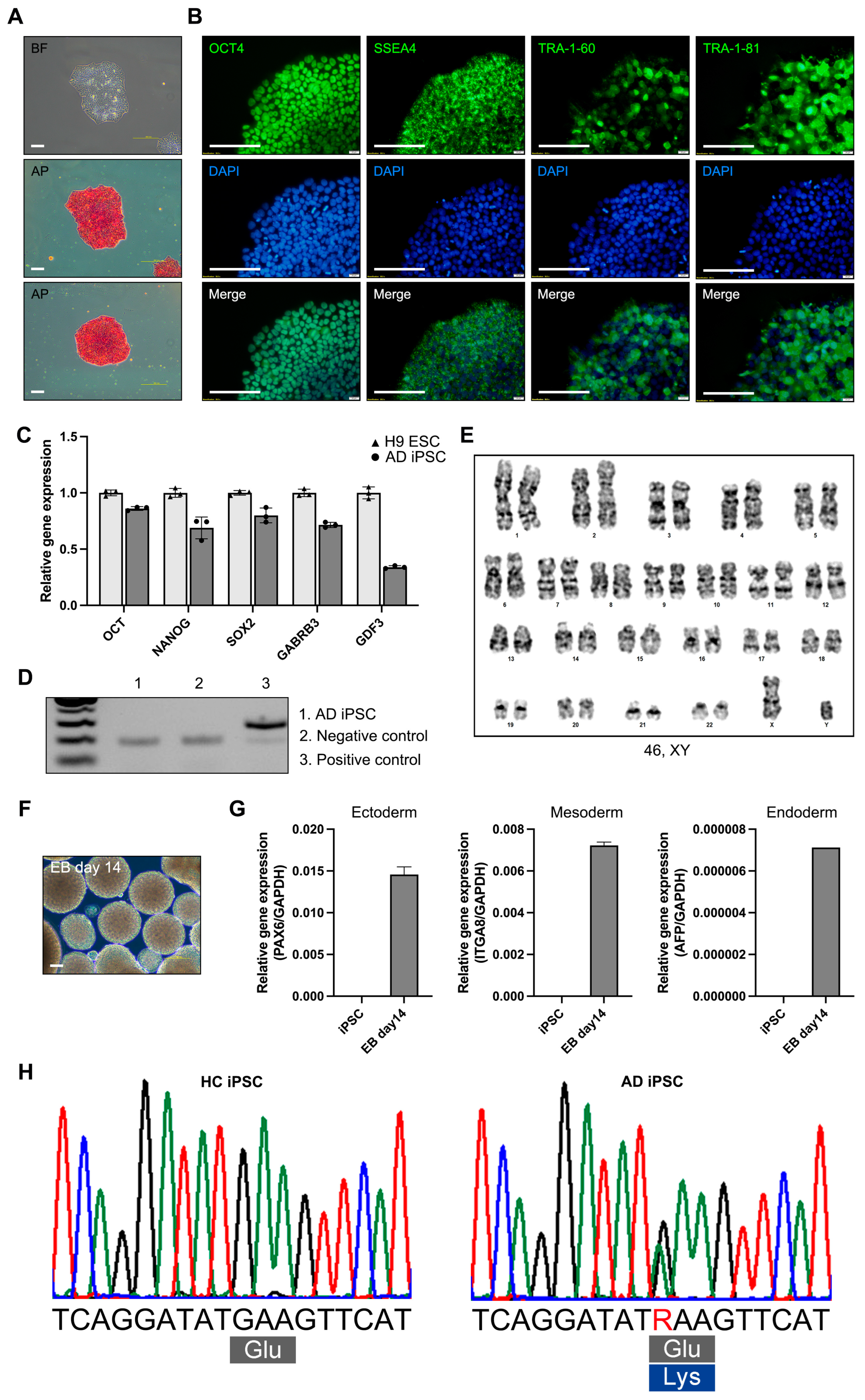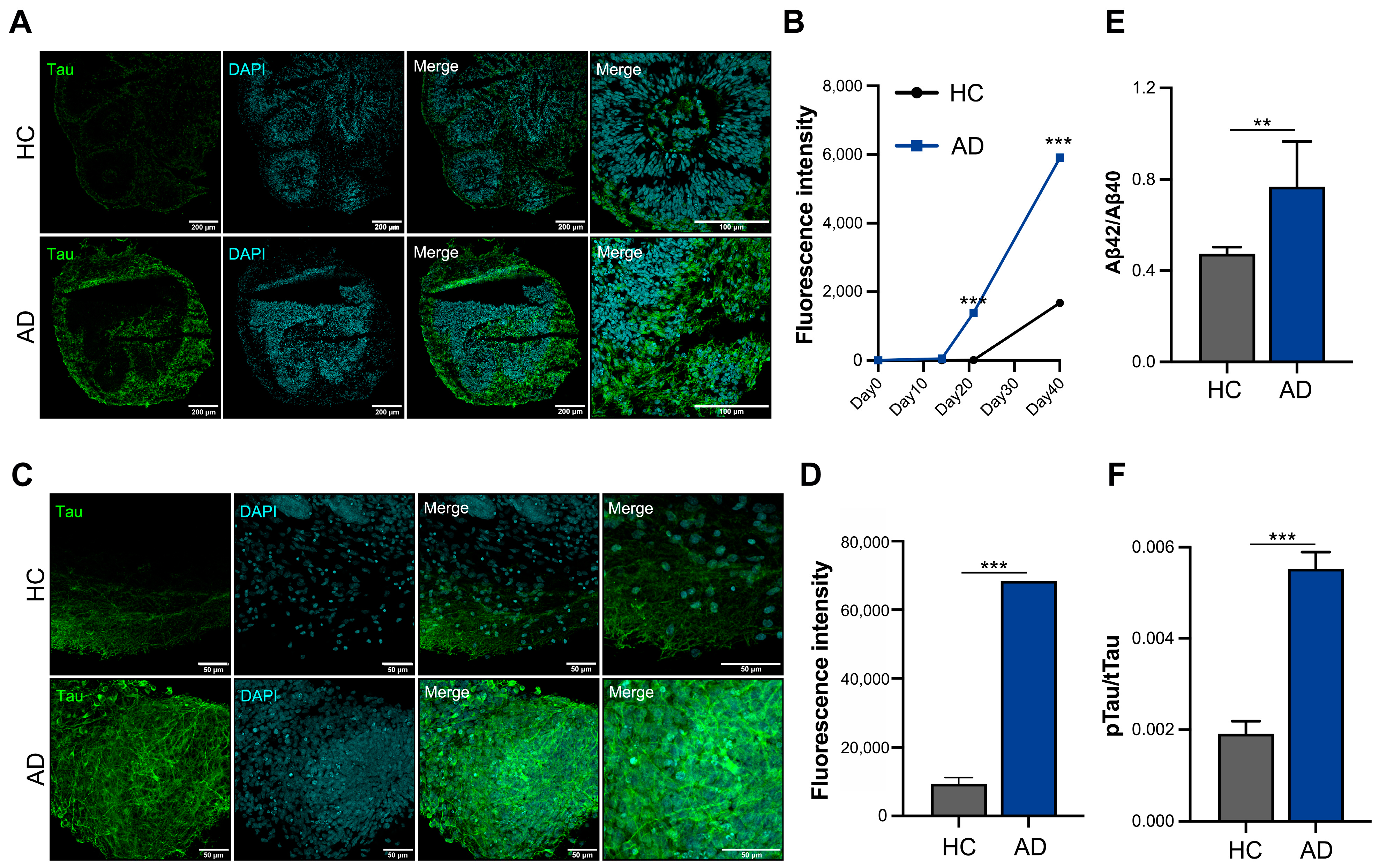Generation of Alzheimer’s Disease Model Derived from Induced Pluripotent Stem Cells with APP Gene Mutation
Abstract
1. Introduction
2. Materials and Methods
2.1. Reprogramming of PBMCs Derived from Patient with AD and Maintenance of iPSCs
2.2. Alkaline Phosphatase Staining and Immunofluorescence Staining of AD iPSCs
2.3. Real-Time Polymerase Chain Reaction (RT-PCR) Analysis of AD iPSC
2.4. Mycoplasma Test of AD iPSC
2.5. Karyotyping of AD iPSC
2.6. In Vitro Three Germ Layer Differentiation of AD iPSC
2.7. Sequencing Analysis
2.8. Differentiation of hiPSC into Cerebral Organoids
2.9. Immunofluorescence
2.10. Whole Staining of Cerebral Organoids
2.11. Enzyme-Linked Immunosorbent Assay (ELISA)
2.12. Statistical Analysis
3. Results
3.1. Reprogramming of PBMCs and Characterization of iPSCs Derived from a Patient with AD
3.2. Differentiation of Cerebral Organoids Using iPSCs Derived from a Patient with AD
3.3. In Vitro Disease Modeling of AD iPSC-Derived Cerebral Organoids
4. Discussion
5. Conclusions
Author Contributions
Funding
Institutional Review Board Statement
Informed Consent Statement
Data Availability Statement
Acknowledgments
Conflicts of Interest
References
- Hardy, J.; Allsop, D. Amyloid deposition as the central event in the aetiology of Alzheimer’s disease. Trends Pharmacol. Sci. 1991, 12, 383–388. [Google Scholar] [CrossRef] [PubMed]
- Ballard, C.; Gauthier, S.; Corbett, A.; Brayne, C.; Aarsland, D.; Jones, E. Alzheimer’s disease. Lancet 2011, 377, 1019–1031. [Google Scholar] [CrossRef] [PubMed]
- Feigin, V.L.; Vos, T.; Nichols, E.; Owolabi, M.O.; Carroll, W.M.; Dichgans, M.; Deuschl, G.; Parmar, P.; Brainin, M.; Murray, C. The global burden of neurological disorders: Translating evidence into policy. Lancet Neurol. 2020, 19, 255–265. [Google Scholar] [CrossRef] [PubMed]
- Li, X.; Feng, X.; Sun, X.; Hou, N.; Han, F.; Liu, Y. Global, regional, and national burden of Alzheimer’s disease and other dementias, 1990–2019. Front. Aging Neurosci. 2022, 14, 937486. [Google Scholar] [CrossRef] [PubMed]
- Vadodaria, K.C.; Jones, J.R.; Linker, S.; Gage, F.H. Modeling Brain Disorders Using Induced Pluripotent Stem Cells. Cold Spring Harb. Perspect. Biol. 2020, 12, a035659. [Google Scholar] [CrossRef]
- Shi, Y.; Inoue, H.; Wu, J.C.; Yamanaka, S. Induced pluripotent stem cell technology: A decade of progress. Nat. Rev. Drug Discov. 2017, 16, 115–130. [Google Scholar] [CrossRef]
- Karagiannis, P.; Takahashi, K.; Saito, M.; Yoshida, Y.; Okita, K.; Watanabe, A.; Inoue, H.; Yamashita, J.K.; Todani, M.; Nakagawa, M.; et al. Induced Pluripotent Stem Cells and Their Use in Human Models of Disease and Development. Physiol. Rev. 2019, 99, 79–114. [Google Scholar] [CrossRef] [PubMed]
- Inoue, H.; Yamanaka, S. The use of induced pluripotent stem cells in drug development. Clin. Pharmacol. Ther. 2011, 89, 655–661. [Google Scholar] [CrossRef]
- Mayhew, C.N.; Singhania, R. A review of protocols for brain organoids and applications for disease modeling. STAR Protoc. 2023, 4, 101860. [Google Scholar] [CrossRef]
- Barak, M.; Fedorova, V.; Pospisilova, V.; Raska, J.; Vochyanova, S.; Sedmik, J.; Hribkova, H.; Klimova, H.; Vanova, T.; Bohaciakova, D. Human iPSC-Derived Neural Models for Studying Alzheimer’s Disease: From Neural Stem Cells to Cerebral Organoids. Stem Cell Rev. Rep. 2022, 18, 792–820. [Google Scholar] [CrossRef]
- Benito-Kwiecinski, S.; Lancaster, M.A. Brain Organoids: Human Neurodevelopment in a Dish. Cold Spring Harb. Perspect. Biol. 2020, 12, a035709. [Google Scholar] [CrossRef] [PubMed]
- Andrews, M.G.; Kriegstein, A.R. Challenges of Organoid Research. Annu. Rev. Neurosci. 2022, 45, 23–39. [Google Scholar] [CrossRef] [PubMed]
- Peterson, S.E.; Westra, J.W.; Rehen, S.K.; Young, H.; Bushman, D.M.; Paczkowski, C.M.; Yung, Y.C.; Lynch, C.L.; Tran, H.T.; Nickey, K.S.; et al. Normal human pluripotent stem cell lines exhibit pervasive mosaic aneuploidy. PLoS ONE 2011, 6, e23018. [Google Scholar] [CrossRef] [PubMed]
- Vanova, T.; Sedmik, J.; Raska, J.; Amruz Cerna, K.; Taus, P.; Pospisilova, V.; Nezvedova, M.; Fedorova, V.; Kadakova, S.; Klimova, H.; et al. Cerebral organoids derived from patients with Alzheimer’s disease with PSEN1/2 mutations have defective tissue patterning and altered development. Cell Rep. 2023, 42, 113310. [Google Scholar] [CrossRef] [PubMed]
- He, Z.; Guo, J.L.; McBride, J.D.; Narasimhan, S.; Kim, H.; Changolkar, L.; Zhang, B.; Gathagan, R.J.; Yue, C.; Dengler, C.; et al. Amyloid-beta plaques enhance Alzheimer’s brain tau-seeded pathologies by facilitating neuritic plaque tau aggregation. Nat. Med. 2018, 24, 29–38. [Google Scholar] [CrossRef] [PubMed]
- Wang, L.; Benzinger, T.L.; Su, Y.; Christensen, J.; Friedrichsen, K.; Aldea, P.; McConathy, J.; Cairns, N.J.; Fagan, A.M.; Morris, J.C.; et al. Evaluation of Tau Imaging in Staging Alzheimer Disease and Revealing Interactions between beta-Amyloid and Tauopathy. JAMA Neurol. 2016, 73, 1070–1077. [Google Scholar] [CrossRef] [PubMed]
- Lewis, J.; Dickson, D.W.; Lin, W.L.; Chisholm, L.; Corral, A.; Jones, G.; Yen, S.H.; Sahara, N.; Skipper, L.; Yager, D.; et al. Enhanced neurofibrillary degeneration in transgenic mice expressing mutant tau and APP. Science 2001, 293, 1487–1491. [Google Scholar] [CrossRef] [PubMed]
- Mashal, Y.; Abdelhady, H.; Iyer, A.K. Comparison of Tau and Amyloid-beta Targeted Immunotherapy Nanoparticles for Alzheimer’s Disease. Biomolecules 2022, 12, 1001. [Google Scholar] [CrossRef] [PubMed]
- de Paula, V.J.R.; Guimaraes, F.M.; Diniz, B.S.; Forlenza, O.V. Neurobiological pathways to Alzheimer’s disease: Amyloid-beta, TAU protein or both? Dement. Neuropsychol. 2009, 3, 188–194. [Google Scholar] [CrossRef]
- Congdon, E.E.; Ji, C.; Tetlow, A.M.; Jiang, Y.; Sigurdsson, E.M. Tau-targeting therapies for Alzheimer disease: Current status and future directions. Nat. Rev. Neurol. 2023, 19, 715–736. [Google Scholar] [CrossRef]
- Congdon, E.E.; Sigurdsson, E.M. Tau-targeting therapies for Alzheimer disease. Nat. Rev. Neurol. 2018, 14, 399–415. [Google Scholar] [CrossRef]
- Haston, K.M.; Finkbeiner, S. Clinical Trials in a Dish: The Potential of Pluripotent Stem Cells to Develop Therapies for Neurodegenerative Diseases. Annu. Rev. Pharmacol. Toxicol. 2016, 56, 489–510. [Google Scholar] [CrossRef]
- Pasteuning-Vuhman, S.; de Jongh, R.; Timmers, A.; Pasterkamp, R.J. Towards Advanced iPSC-based Drug Development for Neurodegenerative Disease. Trends Mol. Med. 2021, 27, 263–279. [Google Scholar] [CrossRef]
- Engle, S.J.; Blaha, L.; Kleiman, R.J. Best Practices for Translational Disease Modeling Using Human iPSC-Derived Neurons. Neuron 2018, 100, 783–797. [Google Scholar] [CrossRef]
- Kim, Y.; Nam, Y.; Rim, Y.A.; Ju, J.H. Anti-fibrotic effect of a selective estrogen receptor modulator in systemic sclerosis. Stem Cell Res. Ther. 2022, 13, 303. [Google Scholar] [CrossRef]
- Dai, S.; Qiu, L.; Veeraraghavan, V.P.; Sheu, C.L.; Mony, U. Advances in iPSC Technology in Neural Disease Modeling, Drug Screening, and Therapy. Curr. Stem Cell Res. Ther. 2024, 19, 809–819. [Google Scholar] [CrossRef] [PubMed]
- Hnatiuk, A.P.; Briganti, F.; Staudt, D.W.; Mercola, M. Human iPSC modeling of heart disease for drug development. Cell Chem. Biol. 2021, 28, 271–282. [Google Scholar] [CrossRef]
- Sharma, A.; Sances, S.; Workman, M.J.; Svendsen, C.N. Multi-lineage Human iPSC-Derived Platforms for Disease Modeling and Drug Discovery. Cell Stem Cell 2020, 26, 309–329. [Google Scholar] [CrossRef] [PubMed]
- Sullivan, S.; Stacey, G.N.; Akazawa, C.; Aoyama, N.; Baptista, R.; Bedford, P.; Bennaceur Griscelli, A.; Chandra, A.; Elwood, N.; Girard, M.; et al. Quality control guidelines for clinical-grade human induced pluripotent stem cell lines. Regen. Med. 2018, 13, 859–866. [Google Scholar] [CrossRef] [PubMed]
- Kim, J.H.; Jo, H.Y.; Ha, H.Y.; Kim, Y.O. Korea National Stem Cell Bank. Stem Cell Res. 2021, 53, 102270. [Google Scholar] [CrossRef]
- D’Avanzo, C.; Aronson, J.; Kim, Y.H.; Choi, S.H.; Tanzi, R.E.; Kim, D.Y. Alzheimer’s in 3D culture: Challenges and perspectives. Bioessays 2015, 37, 1139–1148. [Google Scholar] [CrossRef] [PubMed]



| No | Disease | Sex | Age | Gene | Mutation | Symptom |
|---|---|---|---|---|---|---|
| 1 | Healthy control | M | 50 | - | - | - |
| 2 | Alzheimer’s disease | M | 65 | APP | c.2044G>A (p.E682K) | Amyloid positive |
| Analysis | Target | Length | Primer Sequence |
|---|---|---|---|
| Pluripotency markers | OCT4 | 65 bp | TaqMan Probe ID Hs00742896-s1 |
| NANOG | 109 bp | TaqMan Probe ID Hs02387400-g1 | |
| SOX2 | 121 bp | TaqMan Probe ID Hs00602736-s1 | |
| GABRB3 | 63 bp | TaqMan Probe ID Hs00241459-m1 | |
| GDF3 | 65 bp | TaqMan Probe ID Hs00220998-m1 | |
| Housekeeping gene | GAPDH | 122 bp | TaqMan Probe ID Hs999999905-m1 |
| Three germ layer differentiation markers | PAX6 | 76 bp | TaqMan Probe ID Hs00240871-m1 |
| ITGA8 | 89 bp | TaqMan Probe ID Hs00233321-m1 | |
| AFP | 82 bp | TaqMan Probe ID Hs00173490-m1 | |
| Housekeeping gene | GAPDH | 58 bp | TaqMan Probe ID Hs03929097-g1 |
| Targeted mutation analysis/Sanger sequencing | APP-F1 | 24-mer | CAGGCCTAGAAAGAAGTTTTGGGT |
| APP-F2 | 21-mer | CTAATTGGTTGTCCTGCATAC | |
| APP-R1 | 21-mer | GATTTCTAGCACAGGATGAAC | |
| APP-R2 | 22-mer | GATGAACCAGAGTTAATAGGTC |
Disclaimer/Publisher’s Note: The statements, opinions and data contained in all publications are solely those of the individual author(s) and contributor(s) and not of MDPI and/or the editor(s). MDPI and/or the editor(s) disclaim responsibility for any injury to people or property resulting from any ideas, methods, instructions or products referred to in the content. |
© 2024 by the authors. Licensee MDPI, Basel, Switzerland. This article is an open access article distributed under the terms and conditions of the Creative Commons Attribution (CC BY) license (https://creativecommons.org/licenses/by/4.0/).
Share and Cite
Kim, Y.; Yun, B.; Ye, B.S.; Kim, B.-Y. Generation of Alzheimer’s Disease Model Derived from Induced Pluripotent Stem Cells with APP Gene Mutation. Biomedicines 2024, 12, 1193. https://doi.org/10.3390/biomedicines12061193
Kim Y, Yun B, Ye BS, Kim B-Y. Generation of Alzheimer’s Disease Model Derived from Induced Pluripotent Stem Cells with APP Gene Mutation. Biomedicines. 2024; 12(6):1193. https://doi.org/10.3390/biomedicines12061193
Chicago/Turabian StyleKim, Yena, Binna Yun, Byoung Seok Ye, and Bo-Young Kim. 2024. "Generation of Alzheimer’s Disease Model Derived from Induced Pluripotent Stem Cells with APP Gene Mutation" Biomedicines 12, no. 6: 1193. https://doi.org/10.3390/biomedicines12061193
APA StyleKim, Y., Yun, B., Ye, B. S., & Kim, B.-Y. (2024). Generation of Alzheimer’s Disease Model Derived from Induced Pluripotent Stem Cells with APP Gene Mutation. Biomedicines, 12(6), 1193. https://doi.org/10.3390/biomedicines12061193





